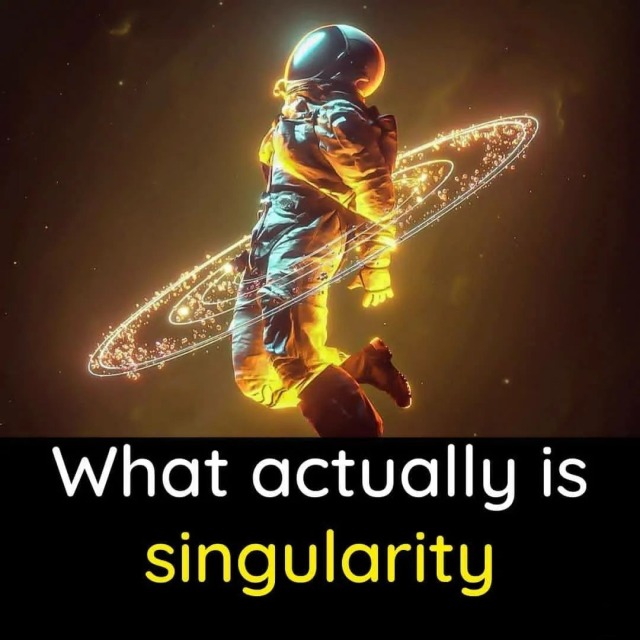#spacetime
Magic Theatre: For Madmen Only

If we describe a Cartesian ordered triad by x,y,z we can describe an analogous 6-dimensional ordered sextuplet or 6-tuple by xa,ya,za,xb,yb,zb
The definitions that translate a 6-dimensional ordered sextuplet (hexagram in Taoist terminology) into a 3-dimensional ordered triad (trigram in Taoist terminology) are:[1]
- (xa + xb) / 2 = x
- (ya + yb) / 2 = y
- (za + zb) / 2 = z
I think the methodology will work for all scalar quantities. But as currently formulated, mandalic geometry (MG) is a discrete geometry based entirely on unit vectors. We are talking about the line segments between -1 and +1 in the various dimensions and only points -1, 0, and +1 in each line segment in Cartesian terms.
In essence we are not yet particularly concerned with scalars here but only with vectors : -, +, and neutral (0).
Mathematically √−1 is important because by adding it to the real number field, as we have done, we create the algebraically complete field of complex numbers. In mathematics, a complete field is a field equipped with a metric and complete with respect to that metric. The real numbers and complex numbers are both complete fields. Cartesian coordinates- - - ordered pairs and ordered triads- - - although based on real numbers, do not form a field. This has important implications, implications which can be ignored only at peril to the particular conceptual system involved..
The definitions above all give three possible results in Cartesian terms: -1, 0, +1. Remember though MG hybridizes six dimensions with three dimensions and represents them superimposed. Wherever one or more zeros occurs in Cartesian coordinates we have also corresponding 6-dimensional forms, composed of just +1s and -1s, of which there are always two for each Cartesian zero. A Cartesian ordered triad with one zero is associated with two such 6-dimensional forms; an ordered triad with two zeros, with four; an ordered triad with three zeros (the origin), with eight. An ordered triad without zeros will have only one associated 6-dimensional form. This constitutes the mandalic pattern, which is an essential feature of the 6D/3D formulation of this geometric system and isomorphism naturally comes into play here as well.
Andthat is how and why all numbers in this coordinate system based on higher-dimensional extensions of the real numbers “square” to numbers which can be either positive or negative and then reduce or "collapse" to corresponding Cartesian forms that preserve the same sign. This is a necessary result of the fact that a primary “zero form” in
6-dimensional terms is lacking, only +1s and -1s exist. These can then interfere constructively and destructively as number waves, to produce a "secondary zero" by destructive interference whenever linked forms differ in sign in one or more paired dimensions. Since the two linked 6-dimensional numbers are always inverse to one another, any Cartesian zero then can be substituted with two such 6-dimensional forms. This is the process that makes imaginary numbers unnecessary, replacing them with two inversely related probable numbers which behave in most ways like real numbers and are distributed throughout the entire geometric system.
“Hybridization” is probably not the best term here but will be used until I can think of a better descriptor. What I intend is not actual joining and unification, but rather a superposition and conceptual commingling in three-dimensional terms. Such a representational mapping substitutes for all Cartesian forms "equivalent" forms containing only 1s and -1s, no zeros. In so doing, it effectively converts the Cartesian coordinate system from just a ring to a field as well, properly interpreted. Basically then, the probable numbers do for the real numbers much the same as the complex numbers do, but with even greater and more utilitarian results which are also more easily managed.
In operational terms, complex numbers perform two rather simple binary operations: a scaling and a rotation. Scaling capability is clearly inherited through its real number lineage; rotational capacity, from its imaginary number lineage. Together, scaling and rotation combine to augment or diminish an axis of growth and produce vector ambulation in a circular path about a central origin point of reference. The scaling factor could be said to detemine the radius of revolution; the rotation factor, the angle of revolution. And that’s pretty much all there is to the “great mystery” of complex numbers. Their importance resides in the great number of fields of endeavor where the combination of these two superpowers is necessary and/or convenient.
Nature uses this combination of scaling and rotation in many of its processes. Atomic and subatomic proceedings are probably not among these. How then did it come about that quantum mechanics arrived at the notion that rotation and scaling could be applicable to modeling of discontinuos states of being? Both refer to changes through continuous space. I think it was an accident of history. In 1925, Erwin Schrödinger, in his search for a way to explain certain mysteries then perplexing the greatest physicists of the day, hit upon his eponymous equation which appeared to do the trick. So well, in fact, that quantum mechanics has been justly considered the single most successful description of reality ever devised. And the equation that basically accomplished this success involves the imaginary number i and complex numbers.[2]
An important aspect of the operation of rotation, one which may have bearing on the Schrödinger equation and its huge success, has been largely overlooked. The result of a rotation can often mimic the result of inversion (reflection through a point), making the two indistinguishable by measurement alone. To someone wearing a blindfold there is no way to tell whether i has by the operations of squaring and rotation changed itself into -1 or -1, the inversion element of multiplication, has simply reflected +1, the identity element of multiplication, through the origin point to -1. Explaining away a 90° rotation with a right angle reflection will no doubt prove more difficult but let’s not just yet deny that it might be doable.
Could there be a way to reformulate the Schrödinger equation then so it contains no imaginary or complex numbers? Many have tried to do that very thing and failed. No one has succeeded in nearly a century. Still, we might wonder if the time is ripe now to remove the blindfold. Perhaps we might do well to inquire whether quantum physics is, in some manner we don’t quite understand, a victim of its own success.
In theory, circumventing use of complex numbers in a defining equation of quantum mechanics should be possible. On what basis do I say this? The equation we have now relies on complex numbers. These in turn derive an ability to produce rotation from the imaginary number √−1 . But there are other mathematical means to accomplish the same. Trigonometry comes most immediately to mind. The circle and cyclicity it models have a very long and distinguished history. Complex numbers as we’ve noted can also produce scaling. But so can real numbers. And close examination reveals that complex numbers inherit their ability to scale from the two real numbers they contain. The hard truth ultimately is there is nothing all that special about complex numbers or complex plane. Possibly it is their utilitarian ease of use that positions them as an attractive methodology. Other routes to ease of use exist as well. There is always more than one way to skin the proverbial cat (even a cat residing only in the mind of a physicist named Schrödinger.)
Consider also, how great is the actual need for scaling in quantum mechanics? The distance from centermost part of the atom to the outer reaches of electron orbital space is in fact quite small. Furthermore, the elements of this universe of discourse are quantized, so actual distances involved are moot. In the extreme, the question persists as to whether “distance” is a concept even applicable in this context of quantum logic. Quantum numbers themselves range between 0 and 2. I can count the allowed values on the fingers of one hand.
Regarding rotation, where exactly does that come into play in the quantum realm? Electrons do not orbit the nucleus of the atom. They jump from orbital to orbital by discretized changes in energy involving photon exchange. In the nucleus it seems such discretized instanteous changes take place as well, obviating any need for rotation. Obviously physics misguided here by labeling one of the quantum numbers “spin”. Sometimes a rose is best referred to as a rose. The problem here is that we don’t really know what it is that “spin” refers to.
The quintessential equation of quantum mechanics was formulated by a physicist, not a mathematician. It is not a simple algebraic equation, but in general a linear partial differential equation, describing the time-evolution of the system’s wave function (“state function”). “Derivations” of the Schrödinger equation do generally demonstrate its mathematical plausibility for describing wave-particle duality. To date, however, there are no universally accepted derivations of Schrödinger’s equation from appropriate axioms. Nor is there any general agreement as to what the equation actually signifies. Moreover, some authors have demonstrated that certain properties emerging from Schrödinger’s equation can even be deduced from symmetry principles alone. This would appear to be a worthwhile direction of investigation to pursue. Quantum mechanics is most fundamentally about symmetry. Let’s make Emmy Noether proud by giving her the recognition she deserves.
Finally, it was not without considerabledifficulty that Schrödinger developed his equation. In the end, it almost seems he pulled it out of a hat, as a magician might a rabbit.[3] Part of the Zeitgeist of the physics community in the early 1920s revolved around the peculiar notion that particles behaved as waves. Schrödinger decided to follow this direction of thought and find an appropriate 3-dimensional wave equation for the electron. His equation succeeded beyond his wildest dreams. Adopted in the canon of the new physics, it became the cornerstone of that radically different physics, changed forever. Physics has never looked back since.
Still, one startling and haunting fact persists: nowhere else in all of physics has it ever been found necessary to invoke complex numbers.
Once, quite a long time ago, I believed imaginary numbers were wrong. I was the one that was wrong. Later, having grown a little more clever, I came to think that √−1 was a necessary evil- - -correct but not validly applicable to quantum physics. Wrong again. Currently it is my belief that imaginary numbers are guilty of an even worse offense: both true from the mathematical standpoint and partly applicable to physics. The worst of both worlds. Yielding results that are in large part correct, imaginary and complex numbers have managed to lead us all down the garden path for the better part of a century. Have we then gone past the point of no return? My contention is that it is possible to complete the ring that Cartesian coordinates present and transform it to a field over the real numbers, with appeal only to higher-dimensional analogues of the reals and no need for imaginary or complex numbers, an approach which, if actually possible, would offer certain undeniable advantages.[4]
Essentially the method of composite dimension does away with i and complex numbers by distributing an operation analogous to that of i throughout six dimensions or three in Cartesian terms and then working with same by means of reflections (inversions) only. So an algebra based on the system necessitates use of only the real numbers and their higher dimension extensions that I have called probable numbers. Only simple addition and multiplication are required. For those in the audience who are "sufficiently mad”, there is the added bonus that a kind of division by zero becomes possible. We’ll find out soon enough whether you qualify.
A few additional explanatory remarks are in order here:
Depending on the variant, Cartesian geometry (CG), represents space in two or three dimensions. Points in the former are referenced to two pairwise perpendicular axes; in the latter, to three.
Because Descartes assumes as axiomatic a 1:1 correspondence of number to spatial location each of his three axes becomes a facsimile of the number line, only in different dimensions.
Mandalic geometry (MG) approaches representation of space differently, using a hybrid coordinate system which relates a higher dimension space to a lower dimension space with a 2:1 correlation.
Itcan be represented entirely commensurate with CG, but in so doing a “glass slipper effect” occurs. Just as Cinderella’s stepsisters can manage to force a too fat foot into her glass slipper, the results leave something to be desired. In our context here, the "something to be desired" is a clear and full understanding of six-dimensional reality in its own right. We end up interpreting it in time-sharing terms of probabilities and randomness.
What Descartes refers to as an ordered pair requires two higher dimension ordered pairs to represent in MG; a Cartesian ordered triad requires three higher dimension ordered pairs to represent in MG.
In Taoist terminology the notational equivalent of a Cartesian ordered pair is a "bigram", a two-line symbol, each line of which can take one of two values. As a result there are four types of bigram. Two bigrams make up a tetragram; three, a hexagram.
Descartes views a point as having only two essential characteristics:
- It is dimensionless.
- It is just a location in space which can be uniquely represented
by a single ordered pairorordered triad.
Mandalic geometry rejects both of these axioms. It regards a point, or a particle so represented, as an evanescent entity emerging from interaction of two higher dimensions expressed in our world of three dimensions in such limited manner.
Thiscan be represented in context of Cartesian space but in making mandalic coordinates commensurate with Cartesian coordinates it is no longer possible to represent every “point” in space uniquely with a single mapping of number to location. What results instead is the probabilistic distribution pattern of the mandala, which we, from our limited vantage in spacetime, misinterpret as something it is not.
MG is a discrete geometry. The result of the mapping formula used is a mandalic configuration in which the 3-dimensional cube composed of unit vectors in Cartesian space becomes a "probability distribution" in combined mandalic space.
I have placed the quotation marksaroundprobability distribution because this is a perspective that arises from our inability to see all that is involved accurately. I suspect this has repercussions pertinent to a full comprehension or grokking of quantum mechanics and possibly of string theory as well.
Since the 64 discrete “points” of the unit vector hypercube of six dimensions represented by the hexagrams cannot “fit” simultaneously in the 27 discrete points of the 3-dimensional unit vector cube by any representational method available to our inherited bio-psychocultural mechanism, a sort of time-sharing process occurs in observations and measurements of reality which we interpret in terms of probability.
What has been described here occurs at enormous velocities close to that of light, and likely refers only to processes in the subatomic quantum realm. For MG, which is also a hybridization of mathematics and physics, context is always of the essence.
There is much more to be said in explanation of mandalic geometry. I see, though, this post has already run rather long, so we will end it here. Enough has already been said in way of introduction of basic material.
Notes
[1] Since the coordinate system is describing a cube with an n-hypercube superimposed, there is an additional constraint placed on all coordinates in
the 6-tuples. All scalar values must be identical for x, y and z values. That constraint assures that all vectors though they may differ in sign (direction) maintain equal magnitudes.
When the 6-tuples are dimensionally reduced to 3-tuples by the method I’ve called “compositing of dimension” the resulting geometric figure consists of four different dimensional amplitudes of 6-tuples collapsed. The amplitudes of dimension correspond in spatial terms to the vertices, edge centers, face centers and cube center. The pattern that emerges is that of a mandala. This is a highly symmetric pattern though all symmetries aren’t necessarily apparent immediately, even using Taoist notation. The probability distribution of the 6-tuples allots the hexagrams in the following manner: one to each vertex; two to each edge center; four to each face center; one to the cube center. The result is placement of 64 6-tuples in 27 positions of discrete 3-tuples in the specific mandalic distribution pattern described.
Think here of the analogy of a hydrogen atom confined within a cubic space of specified side length determined by the nuclear and atomic force fields. The single electron, existing in such quantized energy levels that are possible, can assume various different locations in different orbital shells, but every location in a given orbital must be equidistant from the nuclear proton. Once reduced by dimensional compositing the 6-tuples described here fill four distinct shells that have different radii or distances from the center. From center to periphery these distances can be described as zero; one (or square root one); square root 2; and square root 3. (Pythagorean theorem)
[2] Schrödinger was not entirely comfortable with the implications of quantum theory. About the probability interpretation of quantum mechanics that came out of Solvay ‘27 he wrote: "I don’t like it, and I’m sorry I ever had anything to do with it.“ ["A Quantum Sampler”. The New York Times. 26 December 2005.]
[3] In later years another great physicist, Richard Feynman, would remark, “Where did we get that (equation) from? Nowhere. It is not possible to derive it from anything you know. It came out of the mind of Schrödinger.”
[4] A different approach to avoiding the need for complex numbers from the one I am suggesting is described here. To my mind it offers little of value other than an interesting alternative explanation of what complex numbers are and do. A similar conclusion seems to have been reached by the author.
© 2016 Martin Hauser
Please note: The content and/or format of this post may not be in finalized form. Reblog as a TEXT post will contain this caveat alerting readers to refer to the current version in the source blog. A LINK post will itself do the same. :)
Scroll to bottom for links to Previous / Next pages (if existent). This blog builds on what came before so the best way to follow it is chronologically. Tumblr doesn’t make that easy to do. Since the most recent page is reckoned as Page 1 the number of the actual Page 1 continually changes as new posts are added. To determine the number currently needed to locate Page 1 go to the most recent post which is here. The current total number of pages in the blog will be found at the bottom. The true Page 1 can be reached by changing the web address mandalicgeometry.tumblr.com to mandalicgeometry.tumblr.com/page/x, exchanging my current page number for x and entering. To find a different true page(p) subtract p from x+1 to get the number(n) to use. Place n in the URL instead of x (mandalicgeometry.tumblr.com/page/n) where
n = x + 1 - p. :)
-Page 313-
Beyond Descartes - Part 10
Taoism Meets Boolean Logic: Introduction
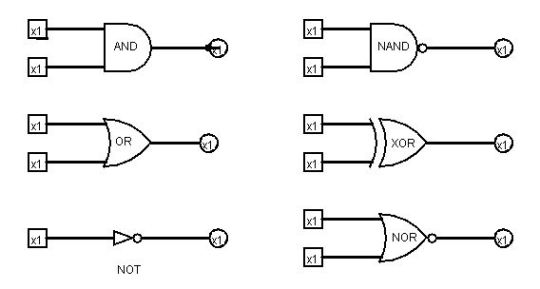
Logic gate symbols
(continued from here)
Before we can hope to comprehend Taoist arithmetic and geometry we need to take a short detour through Boolean logic. First and foremost, we need to see how Boolean logic[1] relates to Cartesian coordinates. That will provide what may be the best foundation available for understanding the Taoist approach to mapping of spacetime and the methodology which mandalic geometry derived from it.[2]
For Descartes, his coordinate system is one thing, his coordinate geometry another. For Taoism, the coordinate system is the geometry.[3] Boolean logic helps to explain how the two perspectives are similar, how different. Cartesian coordinates are static and passive. Taoist coordinates and the derivative mandalic coordinates are active and dynamic. In brief, the latter are changeable and self-changeable, a feat carried out by means of a brand of Boolean logic intrinsic to the system. Although it is true that Descartes’ coordinates do encode much the same information, that is not where their focus of interest lies. Accordingly they turn our own attention elsewhere and we overlook those inherent possibilities.[4]
Descartes’ geometric system is one based on vectors, that is, on both magnitude and direction. But in the scheme of things, the former has somehow eclipsed the preeminence of the latter in the Western hive mind. The opposite is true of Taoist thought and of mandalic geometry. Direction is uniformly revered as primary and prepotent. Magnitude, or scale, is viewed as secondary and subordinate. This mindset allows the Boolean nuances inherent in the system to come to the fore, where they are more easily recognized and deployed.
From such small and seemingly insignificant differences ensue entirely disparate worldviews.
(continuedhere)
Notes
[1] George Boole’s monumental contribution to symbolic logic was published in 1854 but was viewed as only an interesting academic novelty until the second decade of the twentieth century, when it was at last exhumed as a mathematical masterpiece by Whitehead and Russell in their Principia Mathematica.
[2] In Boolean logic (Boolean algebra) logical propositions are represented by algebraic equations in which multiplication and addition (and negation) are replaced with ‘and’ and 'or’ (and 'not’), and where the numbers '0’ and '1’ represent 'false’ and 'true’ respectively. Boolean logic has played a significant role in the development of computer programming and continues to do so.
[3] This is true also of mandalic geometry in its current formulation.
[4] This might be a proper place to proclaim that nature has little use for Descartes’ breed of coordinates, finding them far too stagnant and limiting for her purposes. Fortuitously, she devised her own choice coordinate stock long before Descartes thought to invent his.
© 2015 Martin Hauser
Please note: The content and/or format of this post may not be in finalized form. Reblog as a TEXT post will contain this caveat alerting readers to refer to the current version in the source blog. A LINK post will itself do the same. :)
Scroll to bottom for links to Previous / Next pages (if existent). This blog builds on what came before so the best way to follow it is chronologically. Tumblr doesn’t make that easy to do. Since the most recent page is reckoned as Page 1 the number of the actual Page 1 continually changes as new posts are added. To determine the number currently needed to locate Page 1 go to the most recent post which is here. The current total number of pages in the blog will be found at the bottom. The true Page 1 can be reached by changing the web address mandalicgeometry.tumblr.com to mandalicgeometry.tumblr.com/page/x, exchanging my current page number for x and entering. To find a different true page(p) subtract p from x+1 to get the number(n) to use. Place n in the URL instead of x (mandalicgeometry.tumblr.com/page/n) where
n = x + 1 - p. :)
-Page 293-
Beyond the Enlightenment Rationalists:
From imaginary to probable numbers - VI

(continued from here)
“O Oysters, come and walk with us!” The Walrus did beseech. “A pleasant walk, a pleasant talk, Along the briny beach: We cannot do with more than four, To give a hand to each.”
* * *
“The time has come,” the Walrus said, “To talk of many things: Of shoes–and ships–and sealing-wax– Of cabbages–and kings– And why the sea is boiling hot– And whether pigs have wings.”
-Lewis Carroll, The Walrus and the Carpenter

In this segment, probable numbers will be shown to grow out of a natural context inherently rather than through geometric second thought as transpired in the history of Western thought with imaginary numbers and complex plane. To continue with development of probable numbers it will be necessary to leave behind, for the time being, all preoccupation with imaginary numbers and complex plane. It will also be necessary to depart from our comfort zone of Cartesian spatial coordinate axioms and orientation.
Probable coordinates do not negate validity of Cartesian coordinates but they do relegate them to the status of a special case. In the probable coordinate system the three-dimensional coordinate system of Descartes maps only one eighth of the totality. This means then, that the Cartesian two-dimensional coordinate plane furnishes just one quarter of the total number of corresponding probable coordinate mappings projected to a two-dimensional space.[1] It suggests also that Cartesian localization in 2-space or 3-space is just a small part of the whole story regarding actual spatial and temporal locality and their accompanying physical capacities, say for instance of momentum or mass, but actually encompassing a host of other competencies as well.
Although this might seem strange it is a good thing. Why is it a good thing? First, because nature, as a self-sustaining reality, cannot favor any one coordinate scheme but must encompass all possible - if it is to realize any. Second, because both the Schrödinger equationandFeynman path integral approaches to quantum mechanics say it is so.[2] Third, because Hilbert space demands it. This may leave us disoriented and bewildered, but nature revels in this plan of probable planes. Who are we to argue?
So how do we accomplish this feat? Well, basically by reflections in all dimensions and directions. We extend the Cartesian vectors every way possible. That would give us a 3 x 3 grid or lattice of coordinate systems (the original Cartesian system and eight new grid elements surrounding it), but there are only four different types, so we require only four of the nine to demonstrate. It is best not to show all nine in any case because to do so would place our Cartesian system at direct center of this geometric probable universe and that would be misleading. Why? Because when we tile the two-dimensional universe to infinity in all directions, there is no central coordinate system. Any one of the four could be considered at the center, so none actually is. Overall orientation is nondiscriminative.[3]
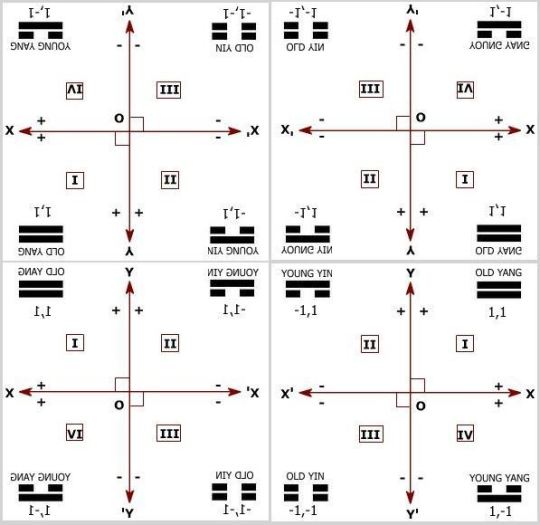
LOOKING GLASS CARTESIAN COORDINATE QUARTET
The image seen immediately above shows four Looking House Cartesian coordinate systems, correlated within a mandalic plane. This mandalic plane is one of six faces of a mandalic cube, each of which is constructed to a different plan but composed of similar building blocks, the four bigrams in various positions and orientations. A 2-dimensional geometric universe can be tiled with this image, recursively repeating it in all directions throughout the two dimensions.[4] It should not be very difficult for the reader to determine which of the four mandalic moieties references our particular conventional Cartesian geometric universe.[5]

It remains only to be added here and now that potential dimensions, probable planes, and probable numbers arise immediately and directly from the remarks above. In some ways it’s a little like valence in chemical reactions. We’ll likely take a look at that combinatory dynamic in context of mandalic geometry at some time down the road. Next though we want to see how the addition of composite dimension impacts and modifies the basic geometry of the probable plane discussed here.[6]
(to be continued)
Top image: The four quadrants of the Cartesian plane. These are numbered in the counterclockwise direction by convention. Architectonically, two number lines are placed together, one going left-right and the other going up-down to provide context for the two-dimensional plane. This image has been modified from one found here.
Notes
[1] To clarify further: There are eight possible Cartesian-like orientation variants in mandalic space arranged around a single point at which they are all tangent to one another. If we consider just the planar aspects of mandalic space, there are four possible Cartesian-like orientation variants which are organized about a central shared point in a manner similar to how quadrants are symmetrically arranged about the Cartesian origin point (0,0) in ordinary 2D space. But here the center point determining symmetries is always one of the points showing greatest rather than least differentiation. That is to say it is formed by Cartesian vertices, ordered pairs having all 1s, no zeros. That may have confused more than clarified, but it seemed important to say. We will be expanding on these thoughts in posts to come. Don’t despair. For just now the important takeaway is that the mandalic coordinate system combines two very important elements that optimize it for quantum application: it manages to be both probabilistic and convention-free (in terms of spatial orientation, which surely must relate to quantum states and numbers in some as yet undetermined manner.) At the same time, imaginary numbers and complex plane are neither.
[2] Even if physics doesn’t yet (circa 2016) realize this to be true.
[3] It is an easy enough matter to extrapolate this mentally to encompass the Cartesian three-dimensional coordinate system but somewhat difficult to demonstrate in two dimensions. So we’ll persevere with a two-dimensional exposition for the time being. It only needs to be clarified here that the three-dimensional realization involves a 3 x 3 x 3 grid but requires just eight cubes to demonstrate because there are only eight different coordinate system types.
[4] I am speaking here in terms of ordinary dimensions but it should be understood that the reality is that the mandalic plane is a composite 4D/2D geometric structure, and the mandalic cube is a composite 6D/3D structure. The image seen here does not fully clarify that because it does not yet take into account composite dimension nor place the bigrams in holistic context within tetragrams and hexagrams. All that is still to come. Greater context will make clear how composite dimension works and why it makes eminent good sense for a self-organizing universe to invoke it. Hint: it has to do with quantum interference phenomena and is what makes all process possible.
ADDENDUM (12 APRIL, 2016)
The mandalic plane I am referring to here corresponds to the Cartesian 2-dimensional plane and is based on four extraordinary dimensions that are composited to the ordinary two dimensions, hence hybrid 4D/2D. It should be understood though that any number of extra dimensions could potentially be composited to two or three ordinary dimensions. The probable plane described in this post is not such a mandalic plane as no compositing of dimensions has yet been performed. What is illustrated here is an ordinary 2-dimensional plane that has undergone reflections in x- and y-dimensions of first and second order to form a noncomposited probable plane. The distinction is an important one.
[5] This is perhaps a good place to mention that the six planar faces of the mandalic cube fit together seamlessly in 3-space, all mediated by the common shared central point, in Cartesian terms the origin at ordered triad (0.0.0) where eight hexagrams coexist in mandalic space. Moreover the six planes fit together mutually by means of a nuclear particle-and-force equivalent of the mortise and tenon joint but in six dimensions rather than two or three, and both positive and negative directions for each.
[6] It should also be avowed that tessellation of a geometric universe with a nondiscriminative, convention-free coordinate system need not exclude use of Cartesian coordinates entirely in all contextual usages. Where useful they can still be applied in combination with mandalic coordinates since the two can be made commensurate, irrespective of specific Cartesian coordinate orientation locally operative. Whatever the Cartesian orientation might be it can always be overlaid with our conventional version of the same. More concretely, hexagram Lines can be annotated with an ordinal numerical subscript specifying Cartesian location in terms of our local convention should it prove necessary or desirable to do so for whatever reason.
On the other hand, before prematurely throwing out the baby with the bath water, we might do well to ask ourselves whether these strange juxtapositions of coordinates might not in fact encode the long sought-after hidden variables that could transform quantum mechanics into a complete theory. In mandalic coordinates of the reflexive nature described, these so-called hidden variables could be hiding in plain sight. Were that to prove the case, David Bohm andLouis de Broglie would be immediately and hugely vindicated in advancing their pilot-wave theory of quantum mechanics. We could finally consign the Copenhagen Interpretation to the scrapheap where it belongs, along with both imaginary numbers and the complex plane.
ADDENDUM (24 APRIL, 2016)
Since writing this I’ve learned that de Broglie disavowed Bohm’s pilot wave theory upon learning of it in 1952. Bohm had derived his interpretation of QM from de Broglie’s original interpretation but de Broglie himself subsequently converted to Niels Bohr’s prevailing Copenhagen interpretation.
© 2016 Martin Hauser
Please note: The content and/or format of this post may not be in finalized form. Reblog as a TEXT post will contain this caveat alerting readers to refer to the current version in the source blog. A LINK post will itself do the same. :)
Scroll to bottom for links to Previous / Next pages (if existent). This blog builds on what came before so the best way to follow it is chronologically. Tumblr doesn’t make that easy to do. Since the most recent page is reckoned as Page 1 the number of the actual Page 1 continually changes as new posts are added. To determine the number currently needed to locate Page 1 go to the most recent post which is here. The current total number of pages in the blog will be found at the bottom. The true Page 1 can be reached by changing the web address mandalicgeometry.tumblr.com to mandalicgeometry.tumblr.com/page/x, exchanging my current page number for x and entering. To find a different true page(p) subtract p from x+1 to get the number(n) to use. Place n in the URL instead of x (mandalicgeometry.tumblr.com/page/n) where
n = x + 1 - p. :)
-Page 311-
Beyond the Enlightenment Rationalists:
From imaginary to probable numbers - II
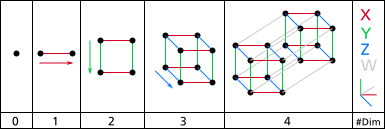
(continued from here)
When a geometric interpretation of imaginary numbers was at last proposed, long after they were invented, it was as though accomplished by central committee. The upshot was easily enough understood but also simplistic. In broad brushstroke here is what seems to have gone down.
The 3 dimensions of Descartes’ coordinate system-a number already deficient from the perspective of mandalic geometry-were reduced to just one. Of the real number axes then only the x-axis remained. This meant from the get-go that any geometric figure that ensued could encompass only linearity in terms of real numbers and dimensions. It was applicable only to a line segment, so the complex plane that resulted could describe just one real dimension and one imaginary dimension. It consecrated the number line in a single dimension, to exclusion of its proper habitation in two others besides. Strike one for imaginary numbers.[1]
With that as background let’s look now at the rotations described by this geometric interpretation of imaginary numbers in the context of the complex plane.
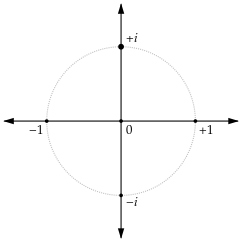
i in the complex or cartesian plane. Real numbers lie on the horizontal axis, and imaginary numbers lie on the vertical axis By Loadmaster (David R. Tribble) (Own work) [CC BY-SA 3.0orGFDL],via Wikimedia Commons
The number 1 is the multiplicative identity element for real numbers and the number -1 is the reflection inversion element for real numbers. Put another way, the number one times any number equals that number; the number -1 times any number is a negative of that number or the inverse number through a reference point, usually taken as zero. Multiplying by 1 then leaves 1, -1, i and -i all unchanged. Multiplying by -1 changes -1 to 1, 1 to -1, i to -i, and -i to i. In terms of rotations in the complex plane, these changes all involve a rotation through 180 degrees. Multiplication of the number 1 by i changes it to i; i by i changes it to -1; -1 by i to -i; and -i by i to 1. These changes all involve rotations through 90 degrees. And finally, multiplication of 1 by -i changes it to -i; -i by -i changes it to -1; -1 by -i to i; and i by -i to 1: all changes involving rotations through -90 degrees.
The figure below shows another way to interpret these rotations that amounts to the same tbing: i1 = i; i2 =-1; i3 = -i; i4 = 1. Click to enlarge.

Four numbers on the real line multiplied by integer powers of the imaginary unit, which corresponds to rotations by multiples of the right angle. By Keφr [CC0],via Wikimedia Commons
I think a committee of some sort must have come up with this resplendent plan. For certain it was an Academy of Mathematics and Sciences that endorsed and enthroned it. All bow to central authority.
I had planned to include a comparison of imaginary numbers and probable numbers in this post as well but because that is a long discussion itself, it will have to wait till the next post. I might add it should prove well worth the wait.
(continuedhere)
Image: A drawing of the first four dimensions. On the left is zero dimensions (a point) and on the right is four dimensions (A tesseract). There is an axis and labels on the right and which level of dimensions it is on the bottom. The arrows alongside the shapes indicate the direction of extrusion. By NerdBoy1392 (Own work) [CC BY-SA 3.0orGFDL],via Wikimedia Commons
Notes
[1] Mathematician William Rowan Hamilton subsequently addressed this deficiency in 1843 with his quaternions, a number system that extends the complex numbers to three-dimensional space. Hamilton defined a quaternion as the quotient of two directed lines in a three-dimensional space or, in other words, as the quotient of two vectors. This complicated matters even more by introducing a non-commutative multiplication operation to the system, though to be fair the quaternion coordinate system has found some useful applications mainly for calculations involving 3-dimensional rotations, as in 3-dimensional computer graphics,computer vision, and crystallographic texture analysis. Still it becomes problematic when theoretical physics attempts use of quaternions in calculations pertaining to atomic and subatomic spaces where rotations do not actually take place. The conclusion to be drawn here is that quaternions can be usefully, if somewhat clumsily, applied to 3-dimensional macro-spaces but are inapproriate for accurate description of higher dimensional spaces. What is here unfortunate and misleading is that quaternions apparently do describe outcomes of events in the quantum realm to some partial degree, if not the mechanisms of the events themselves. Physicists would not long tolerate them were that not so.
[ADDENDUM (24 APRIL, 2016)
Since writing this I’ve learned that quaternions are not currently used in quantum physics nor were they ever, to any great degree, in the past.]
In other words, sometimes the right answer can be reached by a wrong method. In the case under discussion here, we should note that it is possible for a rotation to mimic inversion (reflection through a point). A 90° rotation in two dimensions can mimic a single inversion in a single plane through an edge of a square, and a 180° rotation in two dimensions can mimic a single inversion through a diagonal of a square or two successive inversions through two perpendicular edges of a square. A 180° rotation in three dimensions can mimic three inversions through three mutually perpendicular edges of a square; a combination of one inversion through a diagonal of a square and another through an edge perpendicular to the plane of the first inversion; or a single inversion through a diagonal of the cube. Subatomic paricles exist as discrete or quantized entities and would follow such methods of transformation rather than rotations through a continuous space. Of course, transformations involving a diagonal would require more transformative energy than one involving a single edge.
Such patterns of relationship and transformation could no doubt be described in terms of quantum states and quantum numbers without too much difficulty by a knowledgeable theoretical physicist. Surely doing so could be no more difficult than using quaternions, which may give a correct answer while also misleading and limiting knowledge of the the true workings of the quantum realm by using an incorrect mechanism, one non-commutative to boot. Nature doesn’t approve of hat tricks like that.
© 2016 Martin Hauser
Please note: The content and/or format of this post may not be in finalized form. Reblog as a TEXT post will contain this caveat alerting readers to refer to the current version in the source blog. A LINK post will itself do the same. :)
Scroll to bottom for links to Previous / Next pages (if existent). This blog builds on what came before so the best way to follow it is chronologically. Tumblr doesn’t make that easy to do. Since the most recent page is reckoned as Page 1 the number of the actual Page 1 continually changes as new posts are added. To determine the number currently needed to locate Page 1 go to the most recent post which is here. The current total number of pages in the blog will be found at the bottom. The true Page 1 can be reached by changing the web address mandalicgeometry.tumblr.com to mandalicgeometry.tumblr.com/page/x, exchanging my current page number for x and entering. To find a different true page(p) subtract p from x+1 to get the number(n) to use. Place n in the URL instead of x (mandalicgeometry.tumblr.com/page/n) where
n = x + 1 - p. :)
-Page 307-
InEinstein’s General Theory of Relativity, space and time are unified in a single entity called spacetime. This is the “stage” in which the laws of physics operate.
In Einstein’s theory, the presence of mass and energy warps spacetime, and it is this curvature that affects objects in the way we perceive as gravity. The basic idea is that while we see objects accelerating towards a mass by the effect of a force, in reality is just the object attempting to follow a straight line in this four-dimensional warped space described by General Relativity.
In other words, things fall because they are following a straight line in spacetime.
In usual illustrations, the bending of space is represented as a flat rubber-sheet with masses pressing down on it. This has always bugged me, as it didn’t really represent the nature of 3D space being curved, and it never really addressed the fact that time is also distorted near masses.
This is my first attempt at a better depiction of the effects of General Relativity. Here, we see a 3x3x3 section of an imaginary spatial grid (that extends throughout all of space) being distorted by the presence of a mass. At the intersections of the grid lines there are clocks that show the rate of passage of time at each point in space, relative to a far away observer.
Notice how the clocks near the mass measure time at a slower pace than the clocks further away from the mass.
The distortion of spacetime is real, and can and has been measured experimentally several times. Modern telecommunication satellites and GPS systems all make use of the predictions of General Relativity in order to function.
While bizarre and complex, General Relativity has stood the test of time, and is one of the most well-tested and successful scientific theories ever conceived.
She was having some difficulty with the concept that there is neither space nor time—only processes that transform physical quantities from one to another, from which it is possible to calculate relative possibilities. @galleryhouse_belinda #spacetime #possibilities #popsurrealism #bunnies @jamesfreemangallery @kochxbos @dorothycircus @galerie_benjamin_eck
https://www.instagram.com/p/Bzg6nKtgqvt/?igshid=1lc315j6dmc02
Post link
This is how the space around you would bend if you travel at near-lightspeed
Space cat
Do you believe cats are messengers from other worlds? What do you think look like those who sent them to the Planet Earth. I tried to imagine them and drew this pretty lady in a tight-fitting suit with an antenna on her head. Probably all this is crazy, but quarantine is already literally driving me crazy. And how are you?
I haven’t painted with watercolors for a long time, because I discovered a new technique for creating digital works. But today is the day when I again picked up the brush. I hope you enjoy it
You can find the original work in my Etsy. Link in profile
.
.
.
.
.
.
.
#quarantine #quarantinelife #quarantineartclub #quarantinemood #quarantinecats #quarantine2020 #space #spacestation #spacetime #spacecat #galaxyaesthetic #aestheticart #kawaiifashion #spacecats
https://www.instagram.com/p/CALgLsCnnGC/?igshid=1vkmrcpyuea0l
Post link
@ T h e T r a v e l l e r s ( Redit ) by VegaStarCLiardPhotography
Via Flickr:
©VegaStarCLiardP h o t o g r a p h y vegastarcarpentierphotography.wordpress.com
.
Betz.
.
Under a bridge of the E60 highway, above the Weiss Traun river in Siegsdorf, Bavaria.
Print 1 of a limited edition of 7,
Contact us at [email protected] to buy it.
#limitededition #Bavaria #Germany
#hanslucas #geometry #spacetime #beton #concrete #architecture #landscape #paysage #noiretblanc #blackandwhite #architexture #picoftheday #print #tirage #fineart
@studiohanslucas (à Siegsdorf)
Post link
.
Gonia.
.
On the banks of the Buffalon River, under a bridge of the D999, in the Gard
Print 1 of a limited edition of 7,
Contact us at [email protected] to buy it.
#limitededition #gard #France
#hanslucas #cailloux #geometry #spacetime #beton #concrete #architecture #landscape #paysage #noiretblanc #blackandwhite #architexture #picoftheday #print #tirage #fineart
@studiohanslucas
Post link
.
Navier.
.
On the banks of the Buffalon River, under a bridge of the D999, in the Gard
Print 1 of a limited edition of 7,
Contact us at [email protected] to buy it.
#limitededition #gard #France
#hanslucas #cailloux #geometry #spacetime #beton #concrete #architecture #landscape #paysage #noiretblanc #blackandwhite #architexture #picoftheday #print #tirage #fineart
@studiohanslucas
Post link

